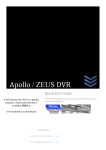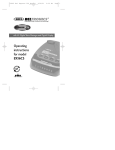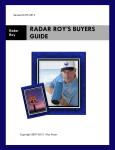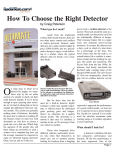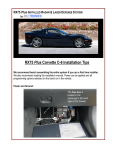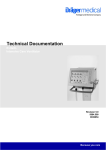Download Beltronics V960/V940 Radar Detector User Manual
Transcript
Head Office 2422 Dunwin Drive Mississauga, Ontario Canada L5L 1J9 Tel: (905) 828-1002 Fax: (905) 828-2951 www.beltronics.com This product is subject to one or more of the following patents: United States #4,571,593 #4,625,210 #4,630,054 #4,939,521 #4,952,936 #4,961,074 #5,402,087 #5,446,923 #5,587,916 #5,600,132 Canada #1,187,586 #1,187,602 #1,295,714 #1,295,715 Other Patents Pending Safety Warning System® L.C.–Patents Pending Printed in Canada 273004-10 ,Fundamental Mixer Technology, FMT and Shadow Technology are registered trademarks of BELTRONICS USA, Inc. VECTOR 960, VECTOR 940, Total Tracking Laser, TTL and AutoScan are trademarks of BELTRONICS USA, Inc. Safety Warning System is a registered trademark of Safety Warning System L.C. VECTOR VECTOR 960 940 THE NEXT GENERATION IN DIGITAL PERFORMANCE k Operating Instructions Model V960 MOTOROLA digitaldna TM Model V940 CONGRATULATIONS! Thank you for purchasing one of BEL’s VECTOR SERIES Radar/Laser/Safety Detectors. BEL’s VECTOR SERIES offers Driver Selectable Features, Digital Voice, Text Messages and the best possible X, K and Super Wideband Ka radar sensitivity available. Enjoy your new detector and be sure to obey all laws where ever you may travel. Remember, owning a Radar detector does not give you a license to speed. Alerts from a Radar detector serve as an effective reminder to check your speed. Laws vary throughout the USA governing the use of a Radar detector. It is your responsibility to follow these laws. SOFTWARE UPGRADABLE VECTOR 960 and VECTOR 940 contain Flash Technology which provides the highest capability to be reprogrammed as the threat of new police traffic radar monitoring technologies emerge. Please ensure that you promptly send in your Consumer Information card. This will ensure you are notified about new traffic monitoring technologies as they emerge. SHADOW TECHNOLOGY® II VECTOR 960 and VECTOR 940 contain Shadow Technology® II making them undetectable to the Interceptor VG-2 Radar Detector Detector. VECTOR 960 and VECTOR 940 provide Driver Selectable Includes 16Selectable Driver Features Selectable Features Features. Driver allow you to “customize” how alerts will be presented to you. 5 Operating Modes 11 General Features 4 Operating Modes 7 General Selectable Features VECTOR 960 Normal ModeVECTOR 960 Modifications Mode 3 Operating Modes 6 General Selectable Features VECTOR 940 Quick-Start VECTOR 940 X Band (10.525 GHz) On/Off Tech Mode 1. AutoMute ON or OFF 1. NORMAL Mode Voltage K Band2.(24.125 GHz) On/Off Radar/Laser Digital A lengthyMeter power upMode test sequence; text messages identify Super Wideband Voice orKaTone (33.4-36.0) alerts received, i.e. “X B a n d ”. (Model V960) AccuSweep™ 2. MODIFICATIONS Mode 2. Radar/Laser/SWS™ Full Power-up test sequence; Operating modes are Digital Voice or Tone presents ONLY those General Selected using PWR Button Selectable Features which you (Model V940) Seehave page 00. altered from factory pre-set. 3. Safety Warning System™ Text messages identify alerts received. AutoMute On/Off ON/OFF 3. QUICK START Mode Radar/Laser Digital Voice No test sequence; unit immediately 4. Safety Warning System™ Prompts On/Off shows last used traveling Digital Voice ON or OFF mode:“A u t o S c a n ”, Safety Warning System™ On/Off (Model V960) “H i g h w a y ”, “Ci t y X” Warning System Digital “Ci t y ALL”, Text messages Safety 5 . Audio/Visual Scroll Rate: Voice or Tone identify alerts received. FAST or SLOW 4. TECH Mode (V960 only) Audio/Visual Scroll Rate 6. Inverted Display Option Full Power-up text sequence. Fast/Slow ON or OFF Text messages identify band received Display Option followed by ACTUAL police trafficInverted 7. AutoScan™, “Highway”, radar or Laser frequency, i.e., AutoScan “City X”or “City ALL.” “24.150” to confirm K band. General Features selected by pressing . General Selectable Features are Operating Modes are ™ selected using the PWR button. (see page 5.) 2 accessed by pressing the PWR and CTY buttons simultaneously, when the unit is OFF. (see page 14.) Note: for convenience AutoScan™ is accessed using the CTY button. (see page 9.) Table of Contents Profile of Features . . . . . . . . . . . . . . . . . . . . . . . . . Getting Started . . . . . . . . . . . . . . . . . . . . . . . . . . . kPower-Up Test Sequence/Start-Up Mode . . . . kTutorial Mode . . . . . . . . . . . . . . . . . . . . . . . . . kSet and Forget Memory . . . . . . . . . . . . . . . . . . kReset to Factory Settings . . . . . . . . . . . . . . . . . kDRK (Bright/Dim/Dark) Button . . . . . . . . . . . kAUD (Auto-Mute/Volume Control) Button . . . kCTY (City/Highway) Button . . . . . . . . . . . . . . Selectable Features . . . . . . . . . . . . . . . . . . . . . . . . kEntering Selectable Features Mode . . . . . . . . . Installation . . . . . . . . . . . . . . . . . . . . . . . . . . . . . . kGeneral Guidelines . . . . . . . . . . . . . . . . . . . . . . Understanding Radar, Laser and SWS™ . . . . . . . . . . Interpretation of Alerts . . . . . . . . . . . . . . . . . . . . . kRadar Alerts . . . . . . . . . . . . . . . . . . . . . . . . . . . kInstant-On/Pulsed Radar Alert . . . . . . . . . . . . kTypical False Alert (Radar) . . . . . . . . . . . . . . . . kLaser Alerts . . . . . . . . . . . . . . . . . . . . . . . . . . . kSafety Warning System® (SWS™) Alerts . . . . . . Performance Verification . . . . . . . . . . . . . . . . . . . . kConditions That Affect Radar Alerts . . . . . . . . kConditions That Affect Laser Alerts . . . . . . . . Troubleshooting . . . . . . . . . . . . . . . . . . . . . . . . . . . Limited Warranty . . . . . . . . . . . . . . . . . . . . . . . . . . Service . . . . . . . . . . . . . . . . . . . . . . . . . . . . . . . . . kWarranty Service . . . . . . . . . . . . . . . . . . . . . . . kPost Warranty Service . . . . . . . . . . . . . . . . . . . Accessories . . . . . . . . . . . . . . . . . . . . . . . . . . . . . . 3 4 5 5 7 8 8 8 9 9 11 14 14 14 17 18 18 21 21 21 22 24 24 24 25 26 27 27 28 29 Profile of Features 6 7 1 8 9 5 2 1. 2. 3. 4. 5. 6. 4 4 3 PWR (Power/Start-Up Mode) Button: pressing and holding PWR will turn the unit on. Continuing to press the PWR button will scroll through the start-up mode options: NORMAL, MODS (Modifications), Q-START (Quick Start), TECH MODE (Model V960 only) plus TUTORIAL MODE. Text Message Display: communicates all mode selections (i.e. DIM, DARK, CITY, HIGHWAY and AUTOMUTE) and confirms Radar band and signal strength, presence of Laser and SWS™ messages received. DRK (Bright/Dim/Dark) Button: provides bright, dark and fully adjustable dim settings of the Text Display for discreet night travel. Audio alerts are not affected. CTY (City/Highway/AutoScan) Button: choose between Autoscan™, Highway, City X or City ALL (X/K/Ka) filtration modes. AUD (Auto-Mute/Volume Control) Button: provides manual muting of all Radar and sws™ alerts. Pressing and holding the AUD button will change the audio level. Antenna Opening: Radar and sws™ signals are received by a patented diecast antenna with integrated transition to microstrip mixer. Note: Model V960 pictured 7. Laser Optical Sensors: collect Laser signals from in 8. Audio Alert Speaker: all audible alerts and Digital front and behind. 9. Voice Messages are emitted from this location. Power Jack: using the straight or coiled cord, VECTOR 960 and VECTOR 940 operate in any vehicle with a 13.8 volt DC negative ground system (10.5 volt to 15.5 volt range). Getting Started k Power-Up Test Sequence/Start-Up Mode Using the supplied straight or coiled power cord, place the end with the “elbow” shaped jack into the receptacle on the side of the detector; the opposite end of the cord connects to the cigarette barrel. Plug the cigarette barrel into your vehicle’s cigarette plug, or the secondary receptacle if your vehicle is so equipped. Press the PWR button to turn the unit ON. Depending upon the Operating Mode selected, the power up test sequence and confirmation of Radar/Laser/SWS™ alerts will be relayed to you as follows: k NORMAL (Factory Pre-Set Mode) A lengthy, power up test sequence that displays audio and text messages for Laser, Ka, K, X and Safety Warning System® (SWS™) followed by the status of the General Selectable Features each time the unit is turned on. When complete, unit is ready for operation and will display Radar, Laser and SWS™ messages when signals are detected. Normal Mode is recommended when first using your VECTOR 985. k MODS (Modifications Mode) Presents audio and text messages for Laser, Ka, K, X and Safety Warning System® (SWS™), followed by ONLY those General Selectable Features which have been modified by the user from their Factory pre-set 5 state each time unit is turned on. Unit is ready for operation and will display Radar, Laser and SWS™ messages when signals are detected. k Q-START (Quick-Start Mode) Unit will bypass the power up test sequence and will display the last selected traveling mode:“A u t o S c a n ” (factory default) “H i g h w a y ”, “Ci t y X” or “Ci t y ALL”. Q-Start is recommended when you are comfortable with the detector and do not require a rundown of sample messages. Unit is ready for operation and will display Radar, Laser and SWS™ messages when signals are detected. ™ k TECH MODE (VECTOR 960 only) Presents audio and text messages followed by the display of the ACTUAL frequency of the received radar bandwidth and Laser. Unit is ready for operation and will display Radar, Laser and SWS™ messages – including actual frequencies – when signals are detected. Sample alerts while operating in Tech Mode: Laser Alert: “LASER 900NM” X Band Alert: “X BAND” followed by “10.525” K Band Alert: “K BAND” followed by “24.150” Ka Band Alert: “Ka BAND” followed by any frequency between 33.4 – 36.0 GHz. 6 Whichever Operating mode you select, VECTOR 960 and VECTOR 940 will be in standby mode and ready to detect traffic Radar, Laser and SWS™ signals. The display will show “A u t o S c a n ” (factory pre-set which is suitable for ALL driving conditions, unless you change this to “H i g h w a y ”, “Ci t y X”, or “Ci t y ALL” (see page 9). ™ k TUTORIAL MODE The Tutorial Mode allows you to become more familiar with all audible and visual alerts. The message “TUTORIAL” appears in the display followed by the audio and corresponding Text Message for “LASER”, “Ka AUDIO”, “K AUDIO”, “X AUDIO”, sample Radar alert and “SAFETY WARNING SYSTEM SAMPLE ALERTS”. Three sample SWS™ messages are then presented in the display along with the corresponding Digital Voice Messages: Note: sample radar and SWS™ messages are random. Presentation of alerts will differ than what is printed based on operation mode selected. Tutorial Mode will cycle continuously until PWR is pressed to exit this mode. Sample 1 “ACCIDENT AHEAD” Sample 2 “HIGHWAY WORKCREW AHEAD” Sample 3 “POL ICE IN PURSUIT” You can access the complete list of SWS™ messages by pressing the AUD button. “MSG 1” will appear in the display once AUD is pressed. Pressing the AUD button a second time will allow you to listen to the SWS™ message while viewing it in the display. (to move forward in the list, press the CTY button; to move backward in the list, press the DRK button). Continue the steps above to play all 60 SWS™ messages. 7 Note: VECTOR 940 provides Digital Voice and Text Messages for the FIVE SWS™ categories only and NOT the individual messages for each category. For example, “MSG 1” will play the category, H i g h w a y C o n s t r u c t i o n / M a i n t e n a n c e. This heading will play for all 11 messages. Refer to the enclosed card for the other category messages. To exit Tutorial Mode, press the PWR button and your unit will be on and ready to receive signals. kSet and Forget Memory Any time your unit is turned off or unplugged from the cigarette lighter socket, all feature settings you have selected are retained in the unit’s memory. Set and Forget Memory eliminates the need to reset your preferred feature settings each time your unit is turned off and then back on. kReset to Factory Settings You can reset your unit to factory settings for Start-Up mode, volume, DRK, AUD, CTY and General Selectable Features. To reset, press and hold the CTY button until the display shows “RESET“ . Two “beeps“ will sound and your unit will cycle through the NORMAL Start-Up Mode. kDRK (Bright/Dim/Dark) Button The DRK button allows selection of a bright, fully adjustable dim or dark mode. Your unit is factory preset to full bright display. To engage dim mode, press and hold the DRK button. The display will cycle through various levels of dim illumination. Release the button at your chosen level. To engage dark mode, press the DRK button a second time. A single “beep” coupled with the brief illumination of “DARK” on the display confirms your selection. You’ll notice an “A s ” (AutoScan™), “H” (Highway mode), “C x ” (City mode) or “CA” (City ALL) remains dim to confirm your unit is receiving power. To return to a full bright setting, press the DRK button a third time; two “beeps” confirm this selection. Use of the DRK button does not affect audio alerts. 8 Important—if you press the the DRK button and do not receive audible confirmation, the audio level has been set too low. k AUD (Auto-Mute/Volume Control) Button Manual Muting of Audio Alerts (Radar and SWS™) k Whether Auto-Mute is selected on or off in Selectable Features, the audio alerts can be completely muted by pressing the AUD button during an alert. The display will briefly show “QU I E T ”. No audible alert will be heard as long as the signal is present. The unit will remain in manual mute mode for approximately 12 seconds from the last received alert. Note—because Laser alerts are not lengthy or sustained, muting is not required (see page 21) k Volume Control Press and hold the AUD button to engage the volume control; the volume will cycle high to low. Release the AUD button when you have reached your desired audio setting. k CTY (City/Highway) Button The CTY button has four functions: 1. AutoScan™ Mode 2. Highway Mode 3. City X Filtration Mode 4. City X/K/Ka Filtration Mode k AutoScan™ Mode : VECTOR 960 and VECTOR 940 are factory shipped with AutoScan™ engaged. Autoscan™ is designed to automatically adjust sensitivity to X and K Band Radar whatever your driving environment. Whether driving in densely populated urban areas or “wide open” rural areas, AutoScan™ will automatically reject virtually all 9 false signals which are shared with traffic Radar on X and K Bands such as door openers and security systems. AutoScan™ is a “no-fuss” means of achieving optimum signal selectivity. 10 k Highway: Select Highway mode when traveling in rural or highway environments for maximum X, K, Super Wideband Ka sensitivity. k City X Mode: Select City X mode when traveling in moderate city conditions of travel, and some level of X band filtration is required. Once engaged, weak X band signals encountered will produce no audible alert until the signal strength reaches a preset level. However, visual alerts will be processed the instant an X band signal is detected, keeping you quietly informed. Since most “false” X band signals are weak, the use of the CTY mode allows you to drive out of their range before they reach the preset level and trigger a full audio alert. k City All Mode (X, K, Super Wideband Ka): This mode is ideal for use in areas where a high level of microwave transmissions can cause falsing on all three Radar bands. In City All mode, your unit will provide an initial short alert coupled with visual confirmation of the band detected and signal strength in the display. No further audible alert is provided until the signal strength reaches a preset level. When no audio alert is provided, the visual alert keeps you quietly informed. Description of Selectable Features There are a total of 11 Driver Selectable Features for VECTOR 960 and 9 Driver Selectable Features for VECTOR 940. These features may be selected depending upon your driving environment and preference. 1. AutoMute ON or OFF 2. Radar/Laser Digital Voice or Tone (Model V960) 2. Radar/Laser/ SWS™ Digital Voice or Tone (Model V940*) 3. Safety Warning System® ON/OFF 4. Safety Warning System® Digital VOICE or TONE (Model V960) 5. Audio/Visual Scroll Rate FAST or SLOW 6. Inverted Display Option ON/OFF 7. AutoScan™ (accessed using CTY Button) 8. Normal Mode (Note: 8-11 accessed using PWR Button) 9. Modifications Mode 10. Q-Start 11. Tech Mode *Display references Radar and Laser only, but does include SWS™ voice as well. 11 k Feature 1 – AutoMute On or Off With “A m u t e o n ”, your unit will provide several X, K or Super Wideband Ka audio alerts followed by the Digital Voice announcement of the signal detected. After the Digital Voice announcement, a “clicking” tone keeps you quietly informed for as long as the signal is present. This clicking becomes more rapid as the strength of the Radar signal increases. “A m u t e o n ” enables you to conveniently monitor extended encounters without having to manually mute or adjust the volume setting. With “A m u t e o f f ”, your unit will provide a continuous series of X, K, Super Wideband Ka audio alerts and Digital Voice announcements of the signal detected. Digital Voice prompts are provided once after the initial audio alert. This standard setting is often preferred when background noise in a vehicle is loud. Factory setting is “A m u t e o f f ”. Note: because of its urgency, Laser alerts are not affected by this mode. k Feature 2 – Radar/Laser Digital Voice Prompts With “V o i c e o n ”, unit will provide Digital Voice prompts followed by “beeps” when X/K/Ka and Laser signals are detected. With “V o i c e o f f ”, unit will sound unique audio tones only. Factory setting is “V o i c e o n ”. Note: For Model V940, the Digital Voice Feature of the five SWS™ categories is included with the Radar/Laser Voice Feature. k Feature 3 – Safety Warning System® (SWS™) With “SWS o n ”, unit will provide a message when signals from SWS™ transmitters are detected. Factory setting is “SWS o n ”. 12 k Feature 4 – Safety Warning System® Voice or Tone (Model V960) When “SWS v o i c e ” is selected, unit will provide Digital Voice announcements when SWS™ transmitters are detected. Factory setting is “SWS v o i c e ”. When “SWS t o n e ” is selected, Digital Voice is replaced by tone/clicking only. Factory setting is “SWS v o i c e ”. k Feature 5 – Audio/Visual Scroll Rate When “SCR s l o w ” is selected, unit will provide a slow cycling of audio/visual messages. When “SCR f a s t ” is selected, unit will provide a fast cycling of audio/visual messages. Factory setting is “SCR s l o w ”. k Feature 6– Inverted Display Feature When selected, your unit can be mounted to the visor using the hook & loop fastener upside down and the display will remain right reading. “Upside down” mounting may allow for easier access to the unit’s functions. Note: Inverted display is ON when the check mark symbol is FLASHING; inverted display is OFF when the underscore line is flashing. 13 Entering Selectable Features Mode 1. With the unit OFF, press and hold the PWR and CTY buttons simultaneously. The word “FEATURES” will appear in the display, followed by the status of the first Selectable Feature. 2. Press the AUD button to make your selection. 3. Press the CTY button to move to the next Selectable Feature. To move backward in the list, press the DRK button. 4. Press the PWR button to exit Selectable Features mode. To confirm your unit is ready for operation, and what mode of travel your unit is operating, the display will read: “A u t o S c a n ”, “H i g h w a y ”, “Ci t y X” or Ci t y ALL. Installation k General Guidelines Do not mount your unit directly behind windshield wipers or mirrored sunscreens which block Radar and Laser signals and substantially reduce warning range. Unlike “after market” mirrored sun-screens, regular tinted glass does not affect Radar reception. Radar signals are also reflected by “heated windshields” known as Instaclear® and ElectriClear® available as an option on some vehicles. This type of windshield makes any dash, visor or windshield mounted detector ineffective. (If in doubt, check with an appropriate dealership to see if this applies to your vehicle.) To achieve optimum performance, regardless of which mounting position you choose, follow the basic steps on the following page. 14 Instaclear is a registered trademark of the Ford Motor Company. ElectriClear is a registered Trademark of Libbey, Owens, Ford, and Delco-Remy. 1. Consider occupant safety when selecting a mounting location. Choose a location where the unit will not be hazardous in case of an accident. 2. For optimum detection, position your unit with a clear, unobstructed view of the road from the front and rear. 3. Do not allow the unit to make contact with the windshield. This will eliminate unnecessary vibration. 4. Avoid placing your unit in direct sunlight. During the summer, interior temperatures of an enclosed vehicle can sometimes reach temperatures that will cause premature aging of the unit. 5. Your detector is not waterproof; exposure to water may cause damage and your warranty will be void. k Dash Mounting You can mount your unit to a level area of your vehicle’s dash using the hook and loop fastener or the four, non-skid dash mounting pads provided. k Windshield 1. Mounting Remove the mounting cover on the top of the detector by pressing on the raised dots and pushing outward. 2. Insert the “grooved” cover plate supplied until it locks into place. 3. Clean the desired area of the windshield, and adhere the windshield/visor bracket by pressing on the suction cups. 4. Slide the detector onto the mounting bracket until it “locks” into place. 15 5. To adjust the angle of the bracket, squeeze and hold the circular “buttons” on the sides of the bracket; this will allow you to angle the bracket to your windshield. Note—some vehicles have a plastic coating on the inside of the windshield designed to protect occupants in case of an accident. Use of the windshield bracket on this type of windshield can permanently mark the surface. Check with your dealer if you are unsure whether your vehicle is equipped with this type of windshield. k Visor 1. Mounting Remove the two suction cups and follow steps 1, 2, 4 and 5. 2. Clip the detector to the edge of the sun visor nearest the windshield. k Fuse Replacement If the fuse has blown, remove the tip from the lighter plug followed by the old fuse. Replace the fuse with a 1-amp, 3AG fuse. Defeating the fuse protection can damage your unit or your vehicle’s electrical system and will void your warranty. Note—the tip is in two pieces; be careful not to lose either piece or the spring inside the holder. (See diagram below). 16 Understanding Radar, Laser and SWS™ k Three Radar Frequencies Three microwave frequencies have been allocated by the FCC (Federal Communications Commission) and are used for traffic Radar. They are: •X Band: 10.525 GHz •K Band: 24.150GHz •Super Wideband Ka: 33.4 GHz to 36.0 GHz Both X and K bands are well known to motorists who have traveled with Radar detectors. Introduced first was X band Radar which became common during the 1960s. In the mid 1970s the lower powered, more difficult to detect K band Radar was introduced. In 1987, FCC approval was given for Radar equipment using a third frequency, Ka. In response to this, BELTRONICS introduced the first Radar detectors capable of detecting X, K and Ka Band signals. In late 1990, FCC approval was given to Wideband Ka: 34.2 GHz to 35.2 GHz. Once again, BEL responded with Wideband Ka detection. Today, BEL’s VECTOR SERIES detects the complete Super Wideband Ka frequency allotted for police monitoring–33.4 GHz to 36.0 GHz. k Total 17 Tracking Laser™ (TTL™) Unlike Radar signals, which are highly reflective, Laser signals have very poor reflective characteristics. Many of today’s Laser detectors do not have the high sensitivity necessary to detect Laser within a large “field of view”. Your unit incorporates BEL’s number one rated Laser detection. Twin Laser ports detect energy far outside the main Laser beam—including off-axis signals—providing the largest achievable 360° “field of view.” The alerts provided by your unit are the same whether signals are received from the front or rear. k Safety Warning System® (SWS™)—What is it? The Radio Association Defending Airwave Rights, Inc. (R.A.D.A.R.) conceived and developed the Safety Warning System®. The concept behind this system is to warn motorists of potential road hazards by employing Safety Warning System® transmitters in areas such as construction zones, accident sites and detours. These SWS™ transmitters operate within the 24 GHz portion of the K band frequency, and broadcast uniquely coded signals that are detected by your unit.I Interpretation of Alerts k Radar Alerts The alerts provided by your unit are affected both by the type of transmission (continuous wave or instanton), and the position of the Radar source. Generally, when you drive closer to a Radar source, the intensity of the received signal increases, resulting in the increase of the number of bar graph segments as well as numerical digit 1 - 9 (Model V960 only) and a corresponding increase in the audio alert rate. Described below are five common types of Radar encounters and the alerts you will typically receive. 1. 18 Stationary or moving Radar, straight ahead or aimed in your direction Since Radar signals travel in a straight line, this Radar encounter potentially offers maximum warning range. Once the signal is received, the initial warning consists of an X, K or Super Wideband Ka audio alert coupled with simultaneous identification of the Radar band (X, K or Ka) and signal strength in the Text Display. The number of bar graph segments displayed depends upon the strength of the signal received. As the strength of the Radar signal increases, the audio alert becomes more rapid and the bar graph will display the maximum number of five segments indicating maximum signal strength. Assuming the Radar signal remains uninterrupted, the audible and visual alerts will clearly indicate a “weak” signal becoming stronger as you drive closer to the Radar source. Remember, when the police Radar source is moving toward you, the Radar signal strength will increase much more rapidly than if you are approaching a stationary source. 2. Stationary Radar aimed around a corner Under this circumstance, reaction time is considerably reduced. Since the Radar signals are transmitted across your line of travel, there is generally no signal available to receive until you are relatively close to the source. Once an alert is received, expect the strength of the signal to increase very quickly. Advanced warning in this situation may be reduced. 19 3. Stationary Radar concealed by the crest of a hill aimed in your direction Radar signals travel in a straight line and do not pass through earth. Consequently, police Radar aimed at the crest of a steep hill cannot be received until you are at or near the top. Warning time may be minimal (as in situation #2) since a strong signal is not present until you are near the crest of the hill. At this point, you may be nearly in the police officer’s line of sight. When cresting a hill, a weak initial alert followed very quickly by a full alert is typical. This alert pattern requires prompt attention. 4. Moving Radar behind you, traveling in the same direction Police Radar signals transmitted from behind your vehicle can be received when reflected by objects in front of you such as large signs, bridges and trucks. As you drive, the size and configuration of these objects are constantly changing causing the strength of any reflected Radar signal received to vary. A strong, uninterrupted alert indicates the patrol car is close behind. 20 k Instant-On/Pulsed Radar This type of signal appears suddenly when a Radar unit is “triggered”. The instant-on alert consists of an intense, three second audio “burst”, coupled with the type of band detected, signal strength digit 1-9 (V960 only) and flashing of the signal strength bar graph in the display. Instant-on/pulsed alert to Ka band K a 9 ■ ■ ■ ■ ■ (V960) K a ■ ■ ■ ■ ■ (V940) k Typical False Alert (Radar) Ideally, a Radar detector should only alert in the presence of police Radar. However, because other devices share X band with police Radar, false alerts sometimes occur. Generally, a false signal produces only a short audio and visual alert. Since they are most often weak, it is possible to drive out of the signal’s range very quickly and receive only a brief alert. Although many times the probable source of the false signal can be identified (supermarket, bank, commercial building, etc.), caution is advised until the source can be confirmed. The X band alert pattern caused by a non-police source can look like the initial alert produced by actual police Radar. For this reason appropriate action is required any time an alert is received. k Laser 21 Alerts When Laser is detected, the display will flash “L A S E R” coupled with a distinct Laser audio alert. If a vehicle is a long distance from the source of Laser pulses, fewer pulses will generally be received. The closer the vehicle is to the source of Laser pulses, the greater the likelihood of receiving a steady stream of Laser pulses. The reason for this is the aiming stability of the Laser gun and the fact that it is difficult to hold the gun absolutely still. Any movement of the gun results in motion of the beam at the target. The further the target, the greater the displacement of the beam and the shorter the dwell time of the beam at the target point. Therefore, there is the possibility of receiving only a few Laser pulses. Due to these characteristics, all Laser alerts should be taken seriously. k Safety Warning System® (SWS™) Alerts With the Safety Warning System® feature ON and an SWS™ transmitter in use, your detector will provide a unique, 2 second SWS™ tone coupled with a Safety Warning System® category word (i.e. “Ha z d Z o n e ” indicating Highway Hazard Zone Advisory) to quickly orient you to the type of situation ahead. This introductory message is followed by a specific Text Message (i.e. “SHARP CURVE AHEAD”) and Digital Voice Message which is repeated twice. After the Digital Voice, the unit will continue to present the message and provide the “clicking“ tone for as long as an SWS™ signal is detected. If two separate SWS™ messages are received, each message is presented twice before the “clicking” resumes. You can replay the last SWS™ message received by pressing the DRK button within 30 seconds of receiving an SWS™ alert. Both Digital Voice and Text Message are replayed. If you have selected “SWS t o n e ” (Digital Voice off), your unit will show just the Text Message (see Selectable Features, page 11). Note—the end of a multiple word SWS™ message is indicated by an asterisk. VECTOR 940 provides only Digital Voice and Text Messages for the FIVE SWS™ categories and not all 22 60 individual messages. Abbreviated SWS™ Category Words “H w y Wo r k ” confirms Highway Construction/Maintenance (messages 1–11) “Ha z d Zo n e ” confirms Highway Hazard Zone Advisory (messages 13–31) “We a t h e r ” confirms Weather Related Hazards (messages 33–41) “Tr a v In fo ” confirms Travel Information/Convenience (messages 43–59) “Mo v i n g ” confirms Emergency/Slow Moving Vehicles in transit (messages 61–64) “Me s s a g e Un k n o w n ” confirms incomplete or unknown messages Note—for a complete listing of the five Safety Warning System® categories and corresponding messages, please refer to the Safety Warning System® Alert Card enclosed with your manual. 23 Performance Verification k Conditions that Affect Radar Alerts If you feel your unit is not alerting properly, keep in mind that there are many conditions that influence the intensity or duration of an alert: 1. The police are using instant-on/pulsed Radar, in which case no signal is transmitted until visual contact has been made with your vehicle. For detection of this signal, you must rely on reflected signals from Radar directed at traffic traveling ahead of you. 2. The police Radar unit is positioned perpendicular to the road, around a curve, or just over the crest of a hill thus significantly reducing the reception range. 3. The highway traffic between your vehicle and the police Radar source is heavy. This blocks/reflects transmitted signals. The presence of several large trucks between you and the police Radar unit could also significantly reduce reception. 4. Rain or humid weather conditions can absorb transmitted signals before they reach your vehicle, again reducing detection range. 5. The police Radar unit is not properly tuned and is transmitting outside the fcc allocated X, K or Super Wideband Ka frequency ranges. k Conditions that Affect Laser Alerts If you feel your unit is not properly alerting to the presence of Laser signals, keep in mind that rain, fog, high humidity and traffic conditions can affect the range that the Laser beam can be detected. 24 Troubleshooting k Solutions for Common Problems If your unit is not operating properly, please refer to the outline below. Problem Possible Cause Corrective Procedure Unit not receiving power Plug not properly inserted Reinsert plug and rotate Fuse in power cord is defective Replace with 1 amp 250 Volt 3ag fuse (see page16) Lighter socket not clean and negatively grounded Consult your dealer or a professional mechanic Fuse or electrical wiring for lighter socket defective Consult your dealer or a professional mechanic Antenna/lens opening partially blocked Reposition unit with unobstructed view of road ahead and behind. Radar signals unable to pass through windshield Determine whether your vehicle has a “heated windshield” known as Instaclear® or ElectriClear®, or is covered with a metallic sun screen. High concentration of non-police X band Use CTY mode or CTY all “Poor detection range” Erratic or frequent alerts sources Review section in this manual on Performance Verification Partial or no display 25 Dim or dark mode engaged Disengage dim or dark mode If you experience a problem with your unit that is not covered in this outline please call, Monday to Friday, 8:30 am–4:30 pm EST, for assistance: 1-800-341-2288 USA 1-800-268-3994 CANADA Limited Warranty 1-Year Warranty–VECTOR 960 / VECTOR 940 1. This warranty covers all defects in materials and workmanship. This warranty does not apply if the unit has been subject to physical abuse, improper installation, modification, or if the housing or serial number of the unit has been removed. 2. The enforceability of this warranty is limited to the original consumer purchaser and is not transferable to, or enforceable by, any subsequent owner. 3. In the event of a defect, malfunction or other failure to conform to this warranty, BELTRONICS will, at its sole discretion, repair or replace the unit at no charge. You are responsible for all shipping costs in connection with warranty service pursuant to this warranty. 4. This warranty commences on the date of retail purchase and shall be effective for a period of one year. 5. There are no express warranties covering the unit other than those set forth in this warranty. All implied warranties are limited to the period of this warranty and no warranties, expressed or implied, extend beyond this period. Some states do not allow limitation on how long an implied warranty lasts, so the above limitation may not apply to you. 26 6. BELTRONICS will in no event be liable for any consequential, incidental, indirect or special damages (including, but not limited to, lost profits) arising out of or in connection with the use, misuse, or function of the unit. Some states do not allow the exclusion of limitation of incidental or consequential damages, so the above limitation or exclusion may not apply to you. 7. This warranty gives you specific legal rights, and you may also have other rights which vary from state to state. 8. You must provide a copy of a dated sales receipt for your unit in order to receive service under warranty. Service k Warranty Service If you feel your detector is not functioning properly please review this manual, particularly the section on Performance Verification. If you still feel service is required, please follow the instructions below. 1. To obtain service during the warranty period, please call the appropriate number below to obtain an RA number and shipping instructions. Remember to return your detector postage paid, insured and in suitable packaging. 1-800-341-2288 USA 1-800-268-3994 CAN 2. For your own protection, obtain a proof of delivery receipt. Shipping costs are your responsibility. 27 3. Enclose with your unit the following information: (a) Your name, complete return address and written description of the problem. (No P. O. Box please.) (b) A telephone number where you can be reached during regular business hours. (c) A copy of your dated sales receipt. k Post-Warranty Service The following arrangements apply if the warranty period has expired or you are not able to provide a copy of your dated sales receipt indicating purchase within the last twelve months. 1. To return your unit, follow steps 1 through 3 (b) under Warranty Service. 2. Enclose with your unit $85 US or $115 Canadian to cover inspection and postage return. Prices subject to change without notice. 28 Accessories If you require any additional accessories, replacement accessories or any accessory which is not included with your unit, call to order or for more information: Monday to Friday, 8:30 am–4:30 pm est. 1-800-341-2288 USA 1-800-268-3994 CANADA DESCRIPTION MODEL NUMBER COST USA COST CANADA •Suction Cup Kit (2) DA-6 $ 2.95 $ 3.95 •Straight Power Cord (12') DA-16 $ 9.95 $ 11.95 •Coiled Power Cord (8') $11.95 $ 16.95 DA-17 •Power Cord Fuses (2) DA-19 $ 3.95 $ 5.95 •Hook & Loop Fastener DA-20 $ 2.95 $ 3.95 $12.95 $ 16.95 •Visor/Windshield Bracket DA-100 •4 Non-Skid Dash Mounting Pads DA-1000 $ 2.95 $ 3.95 •Soft Travel Case DA-62 $13.95 $ 19.95 •Anodized Aluminum Travel Case DA-101 $24.95 $ 32.95 •Owner’s Manual V960/940 n/c n/c Prices subject to change without notice. 29 Notes 30

































